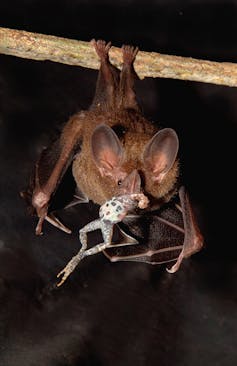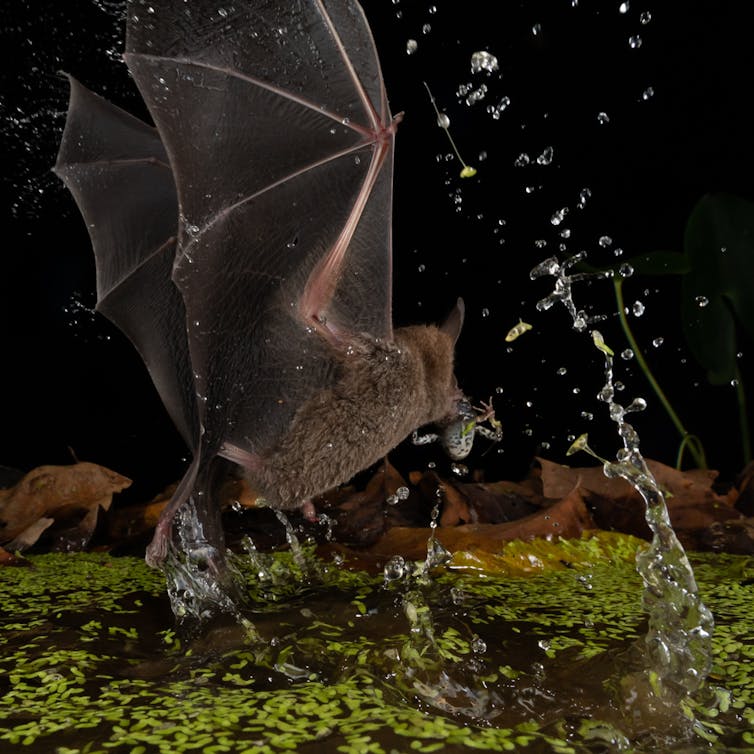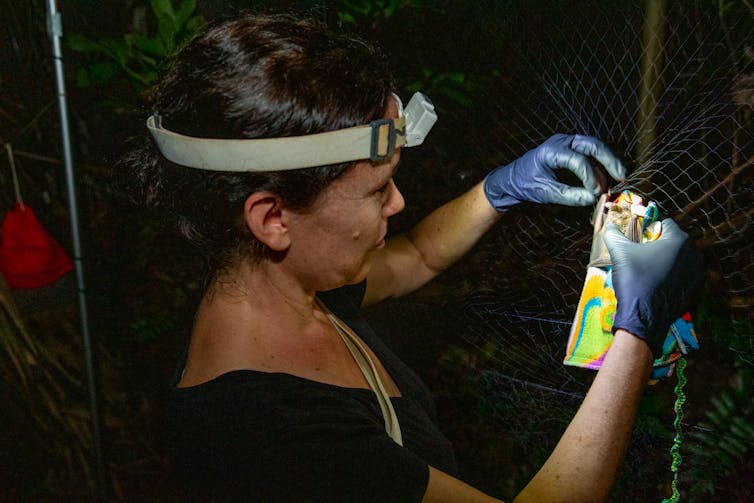Young Bats Learn To Be Discriminating When Listening For Their Next Meal

A frog-eating bat approaches a túngara frog, one of its preferred foods. Grant Maslowski
It is late at night, and we are silently watching a bat in a roost through a night-vision camera. From a nearby speaker comes a long, rattling trill.
The bat briefly perks up and wiggles its ears as it listens to the sound before dropping its head back down, uninterested.
Next from the speaker comes a higher-pitched “whine” followed by a “chuck.”
The bat vigorously shakes its ears and then spreads its wings as it launches from the roost and dives down to attack the speaker.
Bats show tremendous variation in the foods they eat to survive. Some species specialize on fruits, others on insects, others on flower nectar. There are even species that catch fish with their feet.
 The calls male frogs use to attract mates also attract eavesdropping predators. Here, a frog-eating bat consumes an unlucky male túngara frog.
Marcos Guerra, Smithsonian Tropical Research Institute
The calls male frogs use to attract mates also attract eavesdropping predators. Here, a frog-eating bat consumes an unlucky male túngara frog.
Marcos Guerra, Smithsonian Tropical Research Institute
At the Smithsonian Tropical Research Institute in Panama, we’ve been studying one species, the fringe-lipped bat (Trachops cirrhosus), for decades. This bat is a carnivore that specializes in feeding on frogs.
Male frogs from many species call to attract female frogs. Frog-eating bats eavesdrop on those calls to find their next meal. But how do the bats come to associate sounds and prey?
We were interested in understanding how predators that eavesdrop on their prey acquire the ability to discriminate between tasty and dangerous meals. We combined our expertise on animal behavior, bat cognition and frog communication to investigate.
How do bats know the sound of a tasty meal?
There are nearly 8,000 frog and toad species in the world, and each one has a unique call. For instance, the first rattling call that we played from our speaker came from a large and toxic cane toad. The second “whine chuck” came from the túngara frog, a preferred prey species for these bats. Just as herpetologists can tell a frog species by its call, frog-eating bats can use these calls to identify the best meal.
Over the years, our research team has learned a great deal from frog-eating bats about how sound and echolocation are used to find prey, as well as the role of learning and memory in foraging success. In our newly published study, we focused on how associations between the sounds a bat hears and the prey quality it expects arise within the lifespan of an individual bat.
 Adult bats like the one pictured have extensive acoustic repertoires and remember specific frog calls year after year. Young bats must learn which calls to respond to – and, critically, which to ignore – over time through experience.
Grant Maslowski
Adult bats like the one pictured have extensive acoustic repertoires and remember specific frog calls year after year. Young bats must learn which calls to respond to – and, critically, which to ignore – over time through experience.
Grant Maslowski
We considered whether the associations between sound and a delicious meal are an evolved specialty that bats are born with. But this possibility seemed unlikely because the bat species we study has a large geographic distribution across Central and South America, and the species of frogs found across this range vary tremendously.
Instead, we hypothesized that bats learn to associate different sounds with food as they grow up. But we had to test this idea.
First, we and our collaborators spent time in the forest and at ponds to record the mating calls from 15 of the most common frog and toad species in our study area in Panama.
 Rachel Page, one of the lead authors on the study, takes a bat out of a mist net in Panama.
Jorge Alemán, Smithsonian Tropical Research Institute
Rachel Page, one of the lead authors on the study, takes a bat out of a mist net in Panama.
Jorge Alemán, Smithsonian Tropical Research Institute
Then, we set up mist nets along streams in Soberanía National Park to capture wild bats for the study.
Frog call, bat response
For the testing, each bat was housed individually in a large, outdoor flight chamber. From a speaker on the ground in the center, we played calls from one frog species on loop for 30 seconds and measured the behavior of the bat, which was hanging from a cloth roost. As we expected, adult bats were generally uninterested in the sounds of species that were unpalatable, such as those with toxins or those that are too large for the bat to carry.
But it was a different story for young bats. Juveniles responded with significantly more predatory behaviors in response to the calls of toxic toads compared with the adults. They also responded more weakly than adults to the sounds of túngara frogs, a palatable, abundant prey that adult bats prefer.
Thus it seems that juvenile bats must learn the associations between sounds and food over the course of their lives. As they grow up, we believe they learn to ignore the calls of frogs that aren’t worth the trouble and zero in on the calls of frogs that will be a good meal.
To better understand how sounds drive prey associations, we measured the acoustic properties of the different calls. We found that some of the most noticeable features of the calls correlated with body size: Larger frogs produce lower-frequency calls – that is, their voices are deeper. Both the adult and juvenile bats responded more strongly to larger species, which would provide larger meals.
However, there was a clear exception in the responses of adults, where the toxic toads and very large frogs elicited much weaker responses than expected for their body size. This finding led us to hypothesize that bats have early biases to pay attention to sounds associated with larger body size. Then they must learn through experience that meal quality is not only about size. Some large meals are toxic or impossible to carry, making them unpalatable.
Once the researchers have studied each frog-eating bat for a few days, they safely release it where it was originally captured. Footage courtesy of Léna de Framond-Bénard and Eric de Framond-Bénard, compiled by Caroline Rogan.After the bats spent a few days with us, we released each one back at its original site of capture. The bats departed, taking with them a small RFID tag, just like the ones pet owners use to identify their dogs and cats, in case we meet again as part of a future study.
As the bats go on with their lives in the wild, we continue our quest to deepen our understanding of the subtleties of information discrimination. How do individuals weed through information overload to make choices that make sense and benefit them? That’s the same challenge we all face each day.
Logan S. James receives funding from the Smithsonian Tropical Research Institute, McGill University, and the Earth Species Project.
Rachel Page receives funding from the National Science Foundation and the Smithsonian Tropical Research Institute.
Ximena Bernal receives funding from the National Science Foundation and the Smithsonian Tropical Research Institute.


